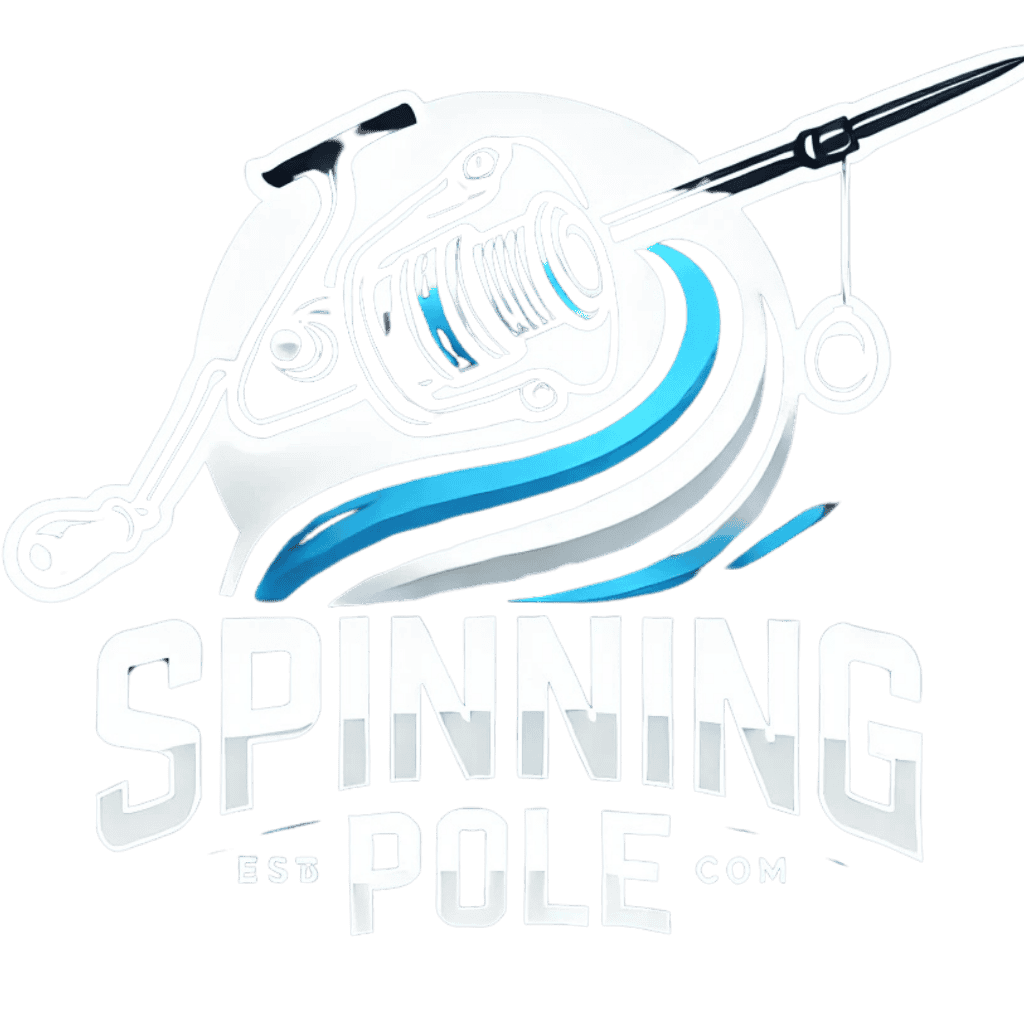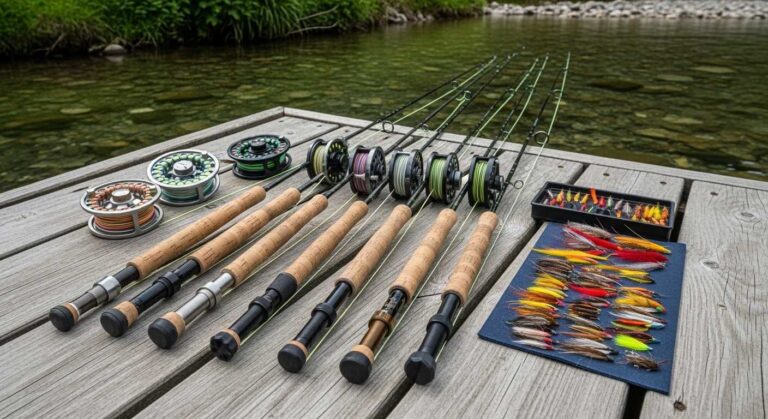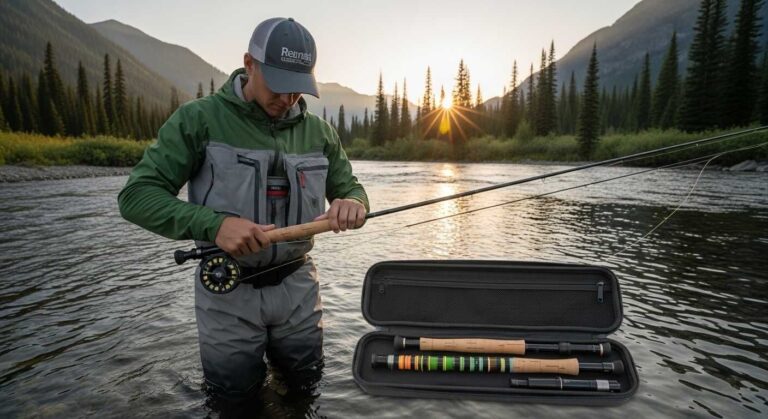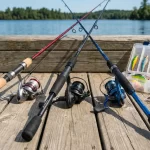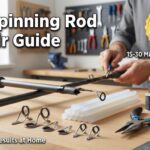Picture this: You’re standing waist-deep in crystal-clear Bahamian waters, the morning sun painting the flats in golden hues, when a permit glides within casting range. You make the perfect presentation, the fish takes, and during the fight, your rod guides seize up from corrosion buildup. I’ve witnessed this heartbreaking scenario more times than I care to count during my 20+ years of saltwater fly fishing.
The harsh reality is that saltwater environments are unforgiving to fishing equipment. Salt crystals, UV radiation, and constant moisture create a perfect storm for corrosion that can destroy even premium fishing rods in a single season without proper protection.
That’s why understanding corrosion-resistant construction isn’t just about extending gear life—it’s about ensuring your rod performs flawlessly when that fish of a lifetime appears.
This comprehensive guide will reveal the materials, technologies, and construction techniques that separate true saltwater fly rods from their freshwater counterparts, helping you make informed decisions that protect both your investment and your fishing success.

Understanding Saltwater Corrosion Challenges
The difference between saltwater and freshwater fly rods extends far beyond simple marketing distinctions. Saltwater environments present unique challenges that demand specialized construction approaches and materials science solutions.
The Science of Salt Corrosion
Salt water contains approximately 35 grams of dissolved salts per liter, creating an aggressive electrolytic environment that accelerates galvanic corrosion. When dissimilar metals come into contact in this environment, electron exchange occurs, causing rapid deterioration of less noble materials.
Traditional freshwater rod components—particularly those featuring standard steel guides, brass fittings, or basic aluminum components—can show visible corrosion within hours of saltwater exposure. This isn’t gradual wear; it’s an aggressive chemical attack that compromises both function and structural integrity.
Environmental Factors Beyond Salt
While salt content drives primary corrosion concerns, saltwater fly fishing environments present additional challenges:
- UV Radiation: Intense tropical sun degrades resins and finishes
- Temperature Extremes: Thermal cycling stresses material bonds
- Abrasive Elements: Sand and coral particles create wear points
- Moisture Persistence: High humidity prevents complete drying
These factors work synergistically, meaning saltwater fly rods must resist multiple forms of degradation simultaneously.

Essential Corrosion-Resistant Materials
Modern saltwater fly rods incorporate sophisticated materials specifically chosen for their resistance to marine environments. Understanding these materials helps anglers evaluate rod construction quality and longevity expectations.
Titanium: The Premium Standard
Titanium represents the gold standard for saltwater fly rod components, particularly guides and hardware. This remarkable metal offers several advantages:
- Corrosion Resistance: Titanium forms a stable oxide layer that self-regenerates when damaged, providing indefinite protection against saltwater corrosion. Unlike stainless steel, which can pit and stain, titanium maintains its integrity even under constant salt exposure.
- Weight Savings: At 45% lighter than steel, titanium guides reduce overall rod weight while maintaining superior strength characteristics.
- Thermal Stability: Titanium’s low thermal conductivity prevents heat buildup during extended fights, maintaining smooth line flow.
Premium manufacturers like Sage utilize titanium Fuji K-guides in their Salt R8 series, while G. Loomis incorporates titanium throughout their NRX+ Saltwater line.
Anodized Aluminum Advantages
High-grade anodized aluminum provides excellent corrosion resistance at more accessible price points. The anodization process creates a controlled oxide layer that’s significantly harder and more corrosion-resistant than base aluminum.
- Marine-Grade Specifications: Look for 6061-T6 aluminum with Type III hard anodizing, which provides superior durability compared to standard anodizing processes.
- Color Coding: Many manufacturers use anodizing colors to indicate material grades—black typically indicates the highest-grade marine anodizing.
Stainless Steel Considerations
While quality stainless steel guides remain industry standard for mid-range saltwater rods, not all stainless steels offer equal protection. 316-grade stainless steel provides superior molybdenum content for enhanced chloride resistance compared to common 304-grade alternatives.
However, even premium stainless steel requires diligent maintenance in saltwater environments and may show pitting after extended exposure.
Rod Blank Construction and Materials
The rod blank itself—while not directly exposed to saltwater—benefits from materials and construction techniques that enhance overall durability and performance in challenging saltwater conditions.
Advanced Carbon Fiber Technology
Modern saltwater fly rods predominantly feature high-modulus carbon fiber blanks designed for the demands of saltwater fishing. These materials offer several advantages over traditional alternatives:
- Modulus Ratings: High-modulus carbon fibers (IM8, IM10, IM12) provide exceptional strength-to-weight ratios essential for handling large saltwater species while maintaining sensitivity for smaller fish.
- Resin Systems: Advanced resin matrices, such as Winston’s SuperSilica system, improve impact resistance and reduce weight while maintaining flex characteristics.
- Multi-Directional Fiber Placement: Sophisticated layup schedules distribute stress loads more effectively, preventing catastrophic failures during extended fights with powerful fish.
Construction Techniques for Saltwater Applications
Saltwater fly rods employ specific construction approaches that differentiate them from freshwater alternatives:
- Reinforced Connection Points: Areas where guides attach receive additional material layers to prevent stress concentration and failure points.
- Progressive Taper Design: Saltwater-specific tapers provide the backbone necessary for heavy flies and windy conditions while maintaining accuracy for precision casting.
- Extended Fighting Butts: Many saltwater designs incorporate removable or integral fighting butts that provide leverage during extended battles without fatiguing the angler.

Guide Systems: The Frontline Defense
Rod guides represent the most vulnerable components in saltwater environments, requiring the highest levels of corrosion protection. The guide system must maintain smooth operation under salt exposure while withstanding the increased forces generated by larger saltwater species.
Titanium Guide Advantages
Premium saltwater fly rods increasingly feature titanium guides, particularly in stripping positions where forces and salt exposure reach maximum levels:
- Fuji Titanium K-Series: These guides feature angled frame designs that prevent line tangles while providing maximum corrosion resistance.
- Single-Foot vs. Double-Foot: Saltwater applications often favor single-foot guides that reduce potential corrosion points while maintaining adequate strength for typical fly rod applications.
- Ring Materials: Ceramic rings (Silicon Carbide or Aluminum Oxide) paired with titanium frames provide smooth line flow and heat dissipation.
Stainless Steel Guide Systems
Quality stainless steel guides remain viable for saltwater use when properly specified and maintained:
- 316-Grade Requirements: Insist on 316-grade stainless steel frames, which contain molybdenum for enhanced chloride resistance.
- Proper Ring Selection: Hard chrome rings or ceramic inserts prevent line wear while resisting salt damage.
- Maintenance Protocols: Stainless steel guides require immediate freshwater rinsing and periodic deep cleaning to maintain optimal performance.
Guide Spacing and Sizing
Saltwater fly rods typically feature modified guide trains optimized for heavier lines and larger flies:
- Oversized Stripping Guides: Large diameter stripping guides accommodate bulky saltwater flies and provide better line control in windy conditions.
- Progressive Sizing: Careful guide progression maintains proper line support while minimizing weight and wind resistance.
- Fighting Guide Placement: Strategic guide placement distributes load during fish fights, preventing line damage and rod failure.
Reel Seat Technology
The reel seat connection point experiences significant stress and salt exposure, making material selection and design critical for long-term reliability.
Anodized Aluminum Reel Seats
Marine-grade anodized aluminum reel seats provide excellent corrosion resistance and secure reel attachment:
- Locking Mechanisms: Quality saltwater reel seats feature positive-locking mechanisms that won’t loosen during extended fights.
- Thread Protection: Sealed threads prevent salt intrusion that could cause seizure or corrosion.
- Insert Materials: Cork or synthetic inserts provide secure grip while resisting salt damage.
Hardware Integration
Premium saltwater fly rods integrate reel seat hardware seamlessly with blank construction:
- Metal-to-Metal Contact: Proper design eliminates galvanic corrosion between dissimilar metals through insulation or material matching.
- Drainage Features: Well-designed reel seats include drainage ports that prevent water accumulation.
- Accessibility: Hardware placement allows thorough cleaning and maintenance access.

Hardware and Component Protection
Beyond major components, small hardware elements require equal attention to corrosion resistance for comprehensive saltwater protection.
Thread Compounds and Sealants
Modern saltwater fly rods incorporate specialized compounds that prevent salt intrusion:
- Marine-Grade Thread Locker: Prevents hardware loosening while allowing disassembly for maintenance.
- Corrosion Inhibitors: Specialized compounds create barriers against galvanic corrosion between dissimilar metals.
- Drainage Facilitation: Proper compound selection allows moisture escape while preventing intrusion.
Protective Finishes
Advanced finish systems provide additional protection layers:
- UV-Resistant Topcoats: Prevent degradation of underlying materials and maintain aesthetic appearance.
- Barrier Coatings: Create physical barriers against salt penetration while maintaining component function.
- Renewable Protection: Some finish systems allow field renewal without factory service requirements.
Brand-Specific Technologies
Leading manufacturers have developed proprietary technologies specifically for saltwater fly rod construction, each offering unique approaches to corrosion resistance.
Sage Salt R8 Technology
Sage’s Salt R8 series incorporates comprehensive saltwater-specific design elements:
- Titanium Fuji K-Guides: Angled design prevents tangles while providing ultimate corrosion resistance.
- Oversized Stripping Guides: Large diameter guides accommodate bulky flies and provide better line control.
- Fighting Butt Integration: Removable fighting butts provide leverage without compromising rod balance.
G. Loomis NRX+ Saltwater Innovation
G. Loomis NRX+ Saltwater rods feature advanced material science:
- Mega Modulus+ Matrix: 15% lighter than original NRX while improving balance and reducing fatigue.
- Dynamic Recovery Technology: Enhanced energy transfer for improved casting distance and accuracy.
- Multi-Taper Design: Optimized tapers provide power for large fish while maintaining finesse capability.
Orvis Helios Blackout Series
Orvis Helios rods incorporate corrosion-resistant features throughout their construction:
- Titanium-Chrome Guide Train: Balanced weight and corrosion resistance for optimal performance.
- Advanced Carbon Matrix: High-modulus fibers provide strength while maintaining sensitivity.
- Integrated Design: Seamless component integration eliminates potential failure points.
Winston Saltwater AIR Technology
Winston’s AIR technology combines advanced materials with innovative design:
- SuperSilica Resin System: Lightweight resin improves toughness while reducing overall weight.
- Boron III Integration: Strategic boron placement provides targeted reinforcement without weight penalty.
- Progressive Taper Design: Optimized actions for various saltwater applications.
Maintenance and Care Practices
Even the most corrosion-resistant saltwater fly rod requires proper maintenance to ensure long-term performance and reliability.
Immediate Post-Fishing Care
Proper maintenance begins the moment you finish fishing:
- Freshwater Rinse: Thoroughly rinse the entire rod with clean freshwater, paying special attention to guides and connections.
- Guide Attention: Use a soft brush to remove salt deposits from guide frames and rings.
- Joint Care: Clean ferrule connections and apply appropriate lubricants to prevent seizure.
- Drying Protocol: Allow complete air drying before storage to prevent trapped moisture issues.
Periodic Deep Maintenance
Regular deep maintenance extends rod life significantly:
- Component Inspection: Examine guides, reel seats, and hardware for early corrosion signs.
- Lubrication Schedule: Apply appropriate lubricants to moving parts and threaded connections.
- Professional Service: Consider annual professional cleaning and inspection for heavily used rods.
Storage Considerations
- Proper storage prevents off-season deterioration:
- Climate Control: Store in low-humidity environments when possible.
- Tube Storage: Use proper rod tubes that allow air circulation while protecting from impacts.
- Separation Protocol: Store rod sections separately to prevent ferrule binding.
Value vs. Performance Analysis
Understanding the relationship between price, materials, and performance helps anglers make informed purchasing decisions based on their specific saltwater fishing applications.
Entry-Level Saltwater Rods
Affordable saltwater fly rods typically feature:
- Stainless Steel Guides: 316-grade stainless provides adequate corrosion resistance with proper care.
- Anodized Aluminum Reel Seats: Marine-grade anodizing offers good protection at accessible price points.
- Standard Carbon Blanks: Lower-modulus carbons provide adequate performance for most applications.
- Price Range: $150-$400 for quality entry-level options like TFO BVK or Orvis Clearwater series.
Mid-Range Performance Options
Mid-tier saltwater fly rods balance performance and affordability:
- Mixed Material Guides: Titanium stripping guides with stainless steel runners provide targeted protection.
- Enhanced Blanks: Higher-modulus carbons improve performance without premium pricing.
- Improved Hardware: Better quality components extend service life significantly.
- Price Range: $400-$700 for rods like Sage Foundation or Scott Sector series.
Premium Saltwater Fly Rods
Top-tier saltwater fly rods feature:
- Full Titanium Guide Trains: Complete corrosion immunity with weight savings.
- Advanced Blank Technology: Proprietary carbon and resin systems maximize performance.
- Comprehensive Protection: Every component is designed for a saltwater environment.
- Price Range: $700-$1,200+ for rods like Sage Salt R8, G. Loomis NRX+, or Winston AIR series.
Cost-Benefit Analysis
When evaluating saltwater fly rod value, consider:
- Fishing Frequency: Heavy saltwater use justifies a premium corrosion resistance investment.
- Target Species: Large, powerful fish require robust construction regardless of price point.
- Maintenance Commitment: Higher-maintenance materials may offset lower initial costs.
- Replacement Costs: Premium rods often prove more economical long-term through extended service life.
Real-World Applications
Understanding how corrosion-resistant construction performs in actual saltwater fishing scenarios helps anglers select appropriate equipment for their specific applications.
Tropical Flats Fishing
Bonefish, permit, and tarpon flats present unique challenges:
- Environment: Shallow, clear water with intense UV exposure and constant salt spray.
- Rod Requirements: Quick-loading actions for accuracy, corrosion resistance for longevity.
- Material Priorities: Titanium guides essential, advanced blanks preferred for performance.
- Recommended Options: Sage Salt R8, G. Loomis NRX+ Saltwater, or Winston AIR series.
Surf and Jetty Applications
Shore-based saltwater fly fishing demands different priorities:
- Environment: Heavy salt spray, sand abrasion, and powerful fish in the current.
- Rod Requirements: Strong backbones, corrosion immunity, and impact resistance.
- Material Priorities: Full corrosion protection throughout, reinforced construction.
- Recommended Options: Hardy Zephrus SWS, Scott Sector, or TFO Mangrove series.
Offshore Pelagic Fishing
Blue water fishing presents maximum challenges:
- Environment: Constant salt exposure, powerful fish, extreme conditions.
- Rod Requirements: Maximum strength, complete corrosion immunity, extended durability.
- Material Priorities: Premium materials throughout, professional-grade construction.
- Recommended Options: Premium 12-weight rods from Sage, G. Loomis, or Winston with full titanium hardware.
Maintenance Intensity by Application
Different fishing environments require varying maintenance commitments:
- Tropical Flats: Daily rinse sufficient, weekly deep clean recommended.
- Surf/Jetty: Immediate thorough cleaning essential, frequent inspection required.
- Offshore: Professional maintenance schedule, complete disassembly, and cleaning.
Frequently Asked Questions
What makes a fly rod truly saltwater-ready?
A genuine saltwater fly rod requires corrosion-resistant materials throughout its construction, not just marketing claims. Key features include marine-grade guide materials (titanium or 316-grade stainless steel), anodized aluminum reel seats, proper drainage design, and advanced blank materials that resist UV degradation. The difference between saltwater and freshwater fly rods extends far beyond simple labeling—it’s fundamental materials science.
Are titanium guides worth the extra cost for saltwater fishing?
For serious saltwater anglers, titanium guides represent excellent long-term value. While initial costs run 40-60% higher than stainless steel alternatives, titanium provides complete corrosion immunity, weight savings, and indefinite service life. If you fish saltwater more than occasionally, titanium guides typically pay for themselves through extended rod life and maintained performance.
How often should I clean my saltwater fly rod?
Immediate freshwater rinsing after every saltwater session is non-negotiable—salt crystals begin forming within hours and can cause permanent damage. Weekly deep cleaning with mild soap removes accumulated residue, while monthly detailed inspection catches early corrosion signs. For heavily used rods, professional annual service ensures optimal long-term performance.
Can I use a freshwater fly rod in saltwater occasionally?
While possible for very limited exposure, freshwater rods lack the corrosion-resistant materials necessary for saltwater durability. Even single-session exposure can cause guide corrosion, reel seat damage, and hardware deterioration. If you plan any regular saltwater fishing, invest in proper saltwater-rated equipment from the start.
What’s the difference between affordable and premium saltwater fly rods?
Premium saltwater fly rods typically feature titanium guide trains, advanced carbon fiber blanks, and comprehensive corrosion protection throughout. Affordable options use stainless steel guides and standard aluminum components, but can provide excellent service with proper maintenance. The key difference lies in maintenance requirements and long-term durability rather than basic fishing capability.
How do I know if my saltwater fly rod needs professional service?
Watch for guide corrosion (pitting, discoloration), reel seat binding, decreased casting performance, or visible finish degradation. If guides show resistance when the line passes through, threads bind during assembly, or the rod feels different during casting, professional inspection is warranted. Annual service for heavily used rods prevents minor issues from becoming major problems.
Are there specific brands known for superior corrosion resistance?
Several manufacturers excel in saltwater fly rod construction: Sage’s Salt series features comprehensive titanium hardware, G. Loomis NRX+ rods incorporate advanced materials throughout, Winston AIR technology provides excellent corrosion resistance, and Hardy Zephrus rods offer proven saltwater durability. However, proper maintenance matters more than brand selection for long-term performance.
What should I look for when buying a used saltwater fly rod?
Inspect guides carefully for corrosion, pitting, or rough surfaces that could damage fly lines. Check reel seat operation—threads should move smoothly without binding. Examine the blank for stress marks, particularly near guide attachments. Ask about maintenance history and consider professional inspection before purchase. Used saltwater rods can offer excellent value but require careful evaluation.
Conclusion
Saltwater fly fishing demands equipment that can withstand one of Earth’s most corrosive environments while delivering peak performance when that perfect cast matters most. Understanding corrosion-resistant construction isn’t just about protecting your investment—it’s about ensuring your gear performs flawlessly, whether you’re sight-casting to permit on Bahamian flats or battling striped bass in heavy surf.
The key takeaways for selecting saltwater fly rods center on materials science: titanium guides provide ultimate corrosion immunity, marine-grade anodized aluminum offers excellent protection at accessible price points, and advanced carbon fiber blanks resist UV degradation while providing the strength necessary for large saltwater species.
Remember that even the most corrosion-resistant saltwater fly rod requires proper maintenance to reach its full potential. Immediate freshwater rinsing, regular deep cleaning, and periodic professional service transform premium equipment into lifetime fishing companions.
Your next step should be evaluating your specific saltwater fishing applications against the technologies and materials we’ve discussed. Whether you’re starting with an affordable rod featuring stainless steel guides or investing in a premium titanium-equipped model, understanding these construction principles ensures you’ll select equipment that enhances rather than limits your saltwater fishing success.
The salt water is calling—make sure your equipment is ready to answer.
